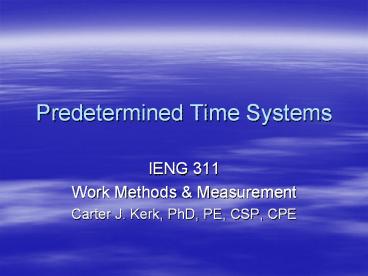Predetermined%20Time%20Systems - PowerPoint PPT Presentation
Title:
Predetermined%20Time%20Systems
Description:
... when it is not possible or practical to set time standards using time study. ... Times for each motion is given in 'TMUs' (see next ) ... – PowerPoint PPT presentation
Number of Views:137
Avg rating:3.0/5.0
Title: Predetermined%20Time%20Systems
1
Predetermined Time Systems
- IENG 311
- Work Methods Measurement
- Carter J. Kerk, PhD, PE, CSP, CPE
2
Predetermined Time Systems
- PDTS
- Read Chapter 29 from Konz Johnson, 6th Edition
- HW29
- Review Questions, p. 580
- Due Monday 10/2
3
Objectives - PDTS
- Describe the general concept of PDTS
- Understand the difference between PDTS and other
standard data systems - Understand the procedure for calculating a time
standard with PDTS - Know the advantages and disadvantages of using a
PDTS for setting time standards
4
Introduction
- There are times when it is not possible or
practical to set time standards using time study. - You may want to use Standard Data (Chapter 30) or
Pre-Determined Time Systems (This chapter!)
5
Therbligs
- Frank and Lillian Gilbreth took a detailed look
at work and broke work into 17 micro-elements,
called Therbligs - They used Therblig analysis to perform
micromotion analysis of tasks (yes, they did this
in the early part of the 1900s) - They used it to analyze bricklaying (a 2000
year-old task) and were able to increase
productivity by 300
6
Therbligs
- G Grasp
- P Position
- PP Pre-position
- U Use
- A Assemble
- DA Disassemble
- RL Release Load
- TE Transport Empty
- TL Transport Loaded
- SH Search
- ST Select
- H Hold
- UD Unavoidable Delay
- AD Avoidable Delay
- R Rest
- PN Plan
- I Inspect
7
The Concept of PDTS
- Take basic, fundamental, universal units of work
- Attach standard amounts of time
- MTM Methods Time Measurement
- MOST (Maynard Operational Sequence Technique)
- MODAPTS
8
MTM
- MTM-1 Basic and most detailed version
- 250 times the cycle time to analyze the task
- Simplified Versions of MTM (less accurate)
- MTM-2 100 times the cycle time to analyze the
task - MTM-3 35 times the cycle time to analyze the
task
9
MTM - 1
- Motions are broken into 20 categories
- Reach, Move, Turn, Apply Pressure, Grasp,
Position, Release, Disengage, Body Motions
(leg-foot, horizontal, vertical), Eye Motions - Times for each motion is given in TMUs (see
next slide) - Times are for experienced operators working at a
normal pace (100) - No allowances are included
10
(No Transcript)
11
(No Transcript)
12
(No Transcript)
13
MOST
- Maynard Operational Sequence Technique
- Developed in Sweden by Zandin
- The vast majority of activities involved with the
handling of an object were associated with a
limited number of motion sequences - By taking advantage of this point, the time
required to perform an analysis is significantly
reduced from that required by MTM without a
reduction in precision.
14
MOST
- Four Sequence Models
- General Move, Controlled Move, Tool Use, Manual
Crane - MiniMOST
- for short-cycle, highly repetitive operations
- This system requires more time
- MaxiMOST
- For long-cycle times, with many non-identical
operations
15
MOST
- Basic MOST
- General Move Sequence
- Three components Get, Put, Return
- Example
- GET A1 B0 G1
- PUT A1 B0 P3
- RETURN A1
- See next slide for General Move Model
16
(No Transcript)
17
What is a TMU?
- TMU Time Measurement Unit
- 1 hour 100,000 TMU
- 1 minute 1667 TMU
- 1 second 27.78 TMU
- 0.00001 hour
- 0.0006 minutes
- 0.036 seconds































